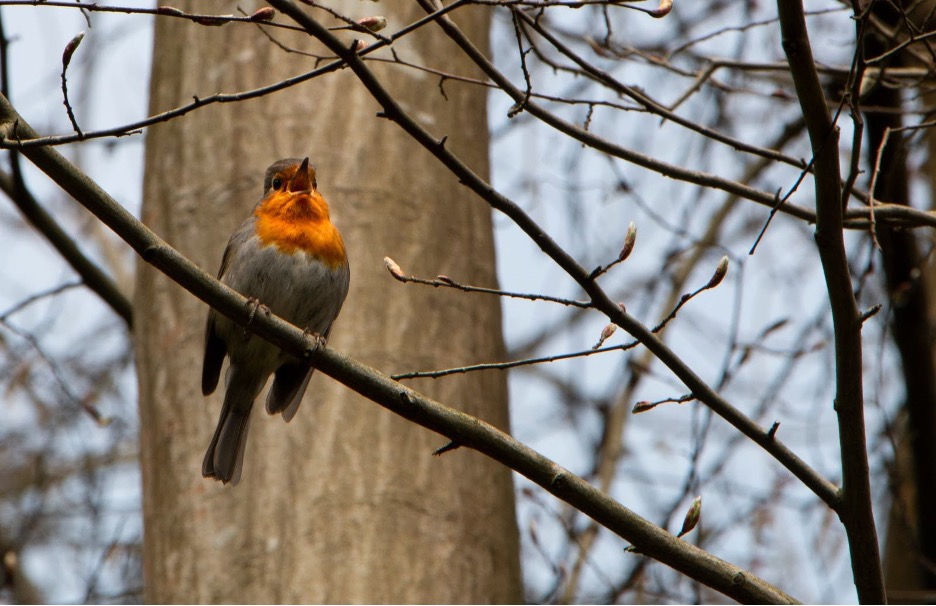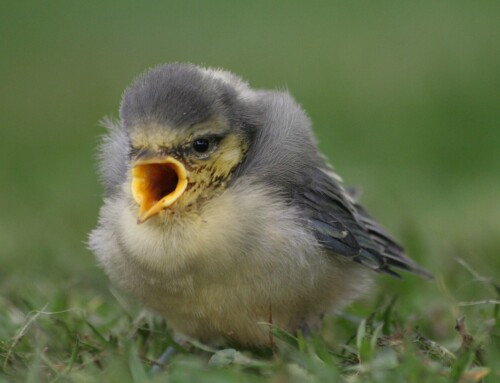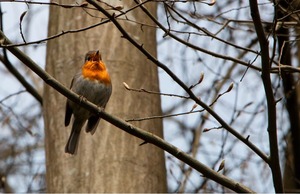 LINKED PAPER
LINKED PAPER
Aggression and multi-modal signaling in noise in a common urban songbird. Önsal, Ç., Yelimlieş, A. & Akçay, Ç. 2022 Behavioral Ecology and Sociobiology. doi: 10.1007/s00265-022-03207-4 VIEW
European Robins (Erithacus rubecula) are common inhabitants of wooded areas and parks in and around European cities. Like many other songbirds in the Northern hemisphere, European Robins use songs and calls to attract mates and defend their territories in the spring (Lack 1943). During territorial defence, the use of such signals of aggressive intent mediates conflicts between two rivals (Francis et al., 2009). Using aggressive signals instead of direct aggression may be favourable since physical aggression during territorial disputes is often costly (Maynard Smith and Price 1973).
The almost omnipresent acoustic noise in cities creates a complication which urban-living songbirds must cope with. Anthropogenic acoustic noise has been shown to change the songs of birds (Gil and Brumm 2014). With the aggressive signal disrupted, territorial disputes between two rivals can be expected to escalate to physical aggression (Logue et al. 2010). Heightened levels of aggression generally seen in the urban-living populations of certain songbirds seems to support this expectation (Evans et al. 2010).
Communication between European Robins during territorial intrusions has been shown to be disrupted by anthropogenic acoustic noise (Kareklas et al. 2019). How is a robin to solve a territorial dispute without turning to dangerous physical attacks? One way could be to shift signalling effort to the less noisy modality – according to the multi-modal shift hypothesis (Partan 2017). European Robins have territorial signals in both the visual and acoustic modalities (Lack 1943). Previous studies found that robins respond both to song and visual signals (Chantrey & Workman 2008). We hypothesised that during simulated intrusions, European Robins would respond with more visual signals and fewer songs under experimental acoustic noise. This shift would depend on urbanisation, with urban birds exhibiting a greater shift than rural birds.
In order to test our hypotheses, we simulated intrusions in the territories of nine urban and 12 rural robins (n=21). We placed two speakers and a 3D-printed model of a European robin in the estimated centre of a male’s territory. We played the songs of another male robins in order to simulate an intrusion. The second speaker was used for noise playback during the noise trial. Each individual received two trials with or without noise. During the trials, we recorded the songs, movements and any visual signals used by the resident male. We took ambient noise measurements after each trial.
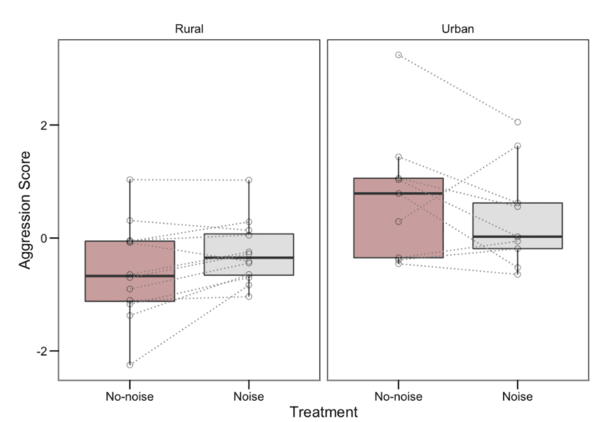
Figure 1 The relationship of aggression scores with habitat and noise treatment. The boxes indicate interquartile ranges, the middle line indicates median, and the whiskers indicate 95% confidence intervals. Dots connected by dotted lines represent data from individual subjects.
Overall, our analyses revealed that urban robins were more aggressive than their rural conspecifics, which was in line with our expectations and the existing body of work on aggression levels of urban and rural birds (Figure 1). As expected, urban robins also used more visual signals and sang less under noise treatment (Figures 2 and 3). However, in contrast with our hypotheses, rural robins were more aggressive under noise, while the aggression levels of urban robins did not differ significantly between the two trials. A possible explanation for urban birds being less aggressive under noise may be that they have adapted to avoid putting energy into territorial disputes when ambient noise is momentarily increased, since the difficulty of communication may result in a high cost to the territory holder. Our results on the relationship between experimental noise playback and the use of visual signals are more difficult to interpret since we found an order effect on visual signals, which were more likely to be used in the first trial.
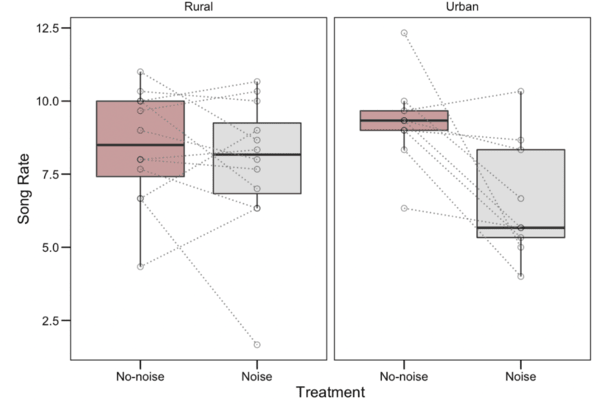
Figure 2 The relationship of song rate with habitat and noise treatment. The boxes indicate interquartile ranges, the middle line indicates median, and the whiskers indicate 95% confidence intervals. Dots connected by dotted lines represent data from individual subjects.
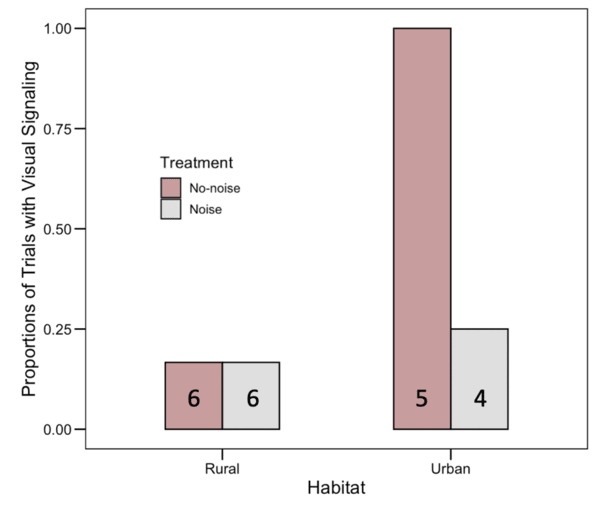
Figure 3 Proportion of first trials where the resident male used visual signals, grouped by habitat and noise treatment. The numbers at the bottom of each bar indicate the total number of subjects for each combination.
Our results suggest a complex relationship of plastic responses and longer-term processes on the way European Robins cope with urban noise. The role of adaptation on the use of territorial signals by urban and rural songbird populations remains to be explored by future studies.
References
Chantrey, D.F. & Workman, L. 2008. Song and plumage effects on aggressive display by the European Robin Erithacus rubecula. Ibis 126: 366-371. VIEW
Evans, J., Boudreau, K. & Hyman, J. 2010. Behavioural syndromes in urban and rural populations of Song Sparrows. Ethology 116: 7: 108871 VIEW
Francis, C.D., Ortega, C.P. & Cruz, A. 2009. Noise pollution changes avian communities and species interactions. Current Biology 19: 1415-1419 VIEW
Gil, D. & Brumm, H. 2013. Acoustic communication in the urban environment: patterns, mechanisms, and potential consequences of avian song adjustments. In: Avian Urban Ecology. Oxford University Press, Oxford
Kareklas, K., Wilson, J., Kunc, H.P. & Arnott, G. 2019. Signal complexity communicates aggressive intent during contests, but the process is disrupted by noise. Biology Letters 15: 20180841 VIEW
Lack, D. 1943. The life of the robin, 1st edn. Witherby, London
Logue, D.M., Abiola, I.O., Rains, D., Bailey, N.W., Zuk, M. & Cade, W.H. 2010. Does signalling mitigate the cost of agonistic interactions? A test in a cricket that has lost its song. Proceedings of the Royal Society B: Biological Sciences 277: 2571-2575 VIEW
Maynard Smith, J. & Price, G. 1973. The logic of animal conflict. Nature 246: 15-18 VIEW
Partan, S.R. 2017. Multimodal shifts in noise: switching channels to communicate through rapid environmental change. Animal Behaviour 124: 325-337 VIEW
Image credit
Top right: European Robin Erithacus rubecula © Alper Yelimlieş (@alperyelimlies).
If you want to write about your research in #theBOUblog, then please see here.



